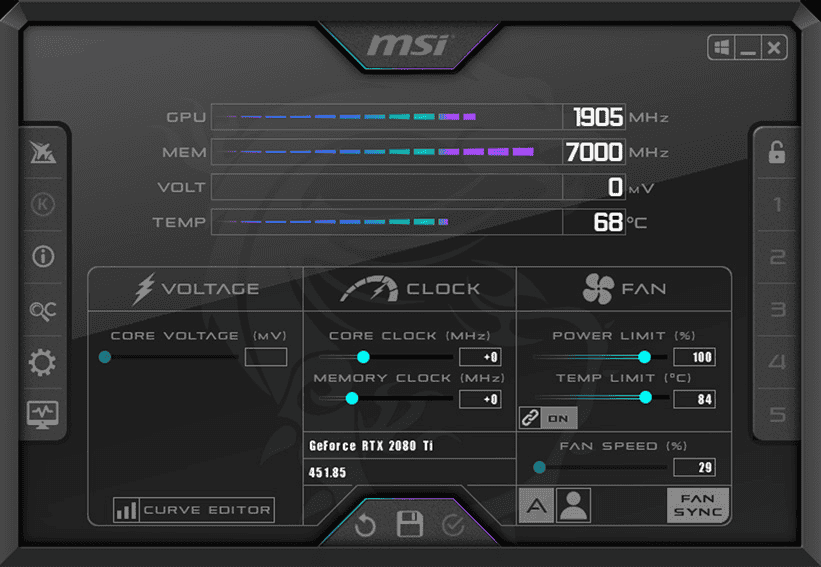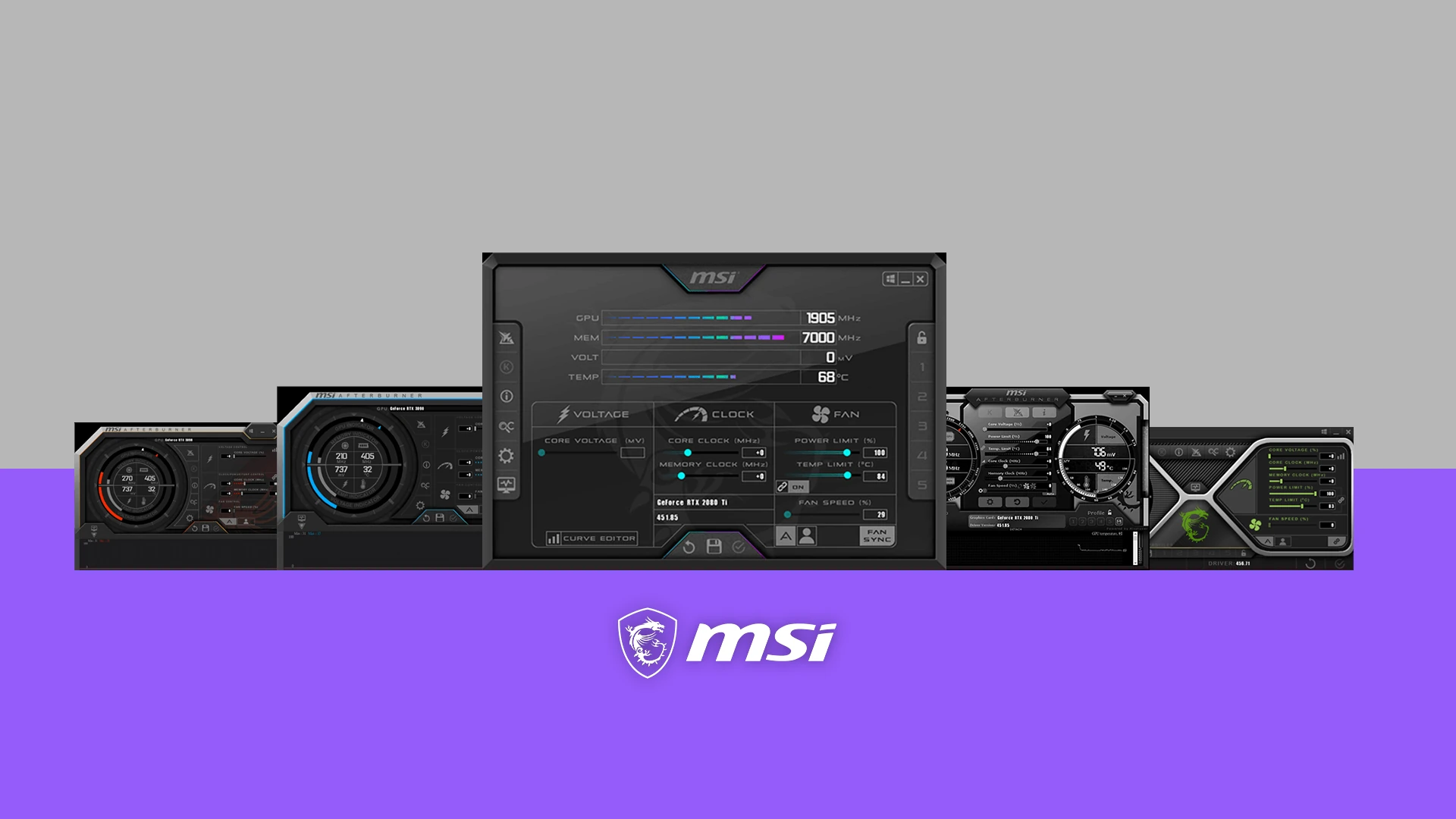MSI has introduced an update to its Afterburner software, adding standalone fan controls in anticipation of the NVIDIA GeForce RTX 50 series graphics cards. This feature enhances users’ ability to manage GPU performance and cooling, especially critical for high-end models that generate considerable heat.
Improved cooling is essential to prevent thermal throttling and maintain optimal performance. The new fan control allows for customization, potentially leading to quieter operation and better overclocking capabilities, ensuring enthusiasts can maximize their hardware’s efficiency.
Enhanced Cooling Control with MSI Afterburner
What is MSI Afterburner?
MSI Afterburner is a popular tool for overclocking and monitoring graphics cards. It lets users adjust various settings, such as clock speeds, voltage, and fan speeds. This allows for increased performance or quieter operation, depending on user preference.

New Fan Control Features
A recent update to MSI Afterburner brings new fan control features, especially important with the arrival of the RTX 50 series GPUs. The RTX 5080 is rumored to have three separate fan controllers, a change from the two controllers found on older cards. This change means more control over cooling.
The updated Afterburner software lets users control each fan independently. This is called asynchronous fan control. It allows fine-tuning for better cooling and less noise. For example, if one part of the card runs hotter, its fan can spin faster, while others can remain quiet.
Why is This Important?
Better fan control has many benefits:
- Improved Cooling: Independent fan control allows for better cooling, which is vital for high-performance GPUs like the RTX 50 series.
- Reduced Noise: By controlling each fan, users can minimize noise. Fans only need to spin as fast as needed to keep the card cool.
- Enhanced Overclocking: Better cooling makes overclocking easier. Users can push their cards harder without worrying about overheating.
How Does it Compare to Other Software?
Many graphics card makers offer their own software for fan control. However, MSI Afterburner is popular because it works with cards from different brands. This makes it a good choice for people who build their own PCs with parts from different companies. It also provides more detailed control than some manufacturer-provided software.
Pros and Cons
| Feature | Pros | Cons |
|---|---|---|
| Independent Fan Control | Fine-tuned cooling, reduced noise | May require some technical knowledge |
| Cross-Brand Compatibility | Works with most graphics cards | Software updates are needed for new hardware |
| Detailed Monitoring | Shows detailed information about the GPU | Can be overwhelming for new users |
How to Use It
Using the new features is simple. After installing the updated MSI Afterburner software, users will see options to control each fan. They can adjust the speed of each fan separately. This allows for custom fan curves based on temperature.
Addressing Common Questions
Will this work with older GPUs? While the new features are designed for the RTX 50 series, MSI Afterburner also works with older cards. Basic fan control is available for most GPUs.
Is it free? Yes, MSI Afterburner is a free tool.
Alternatives to MSI Afterburner
While MSI Afterburner is a great tool, some alternative options exist.
GPU Tweak III: This is ASUS’s software for overclocking and monitoring. It offers similar features to Afterburner, but only works with ASUS cards.
RivaTuner: This is another powerful tool for hardware monitoring and tuning. It is often used with Afterburner.
These alternatives offer similar basic functions, but Afterburner’s cross-brand compatibility and detailed controls make it a popular choice.
Understanding GPU Temperature and Its Impact
Keeping your graphics card cool is important for performance and lifespan. High temperatures can cause performance drops and even damage the card over time. Most GPUs are designed to operate safely up to around 90 degrees Celsius. However, keeping temperatures below 80 degrees is ideal for optimal performance and longevity. Using tools like MSI Afterburner to manage fan speeds is one way to achieve this. Other methods include ensuring proper case airflow and using better cooling solutions, like liquid cooling. By monitoring temperatures and taking steps to keep them in check, you can ensure your graphics card performs its best for years to come.
Short Summary:
- MSI Afterburner will receive an update to support three independent fan controllers for RTX 5080 cards.
- The update is set to launch in conjunction with the release of NVIDIA’s new GPU series in January.
- Users can expect enhanced cooling management and performance tuning capabilities with the updated Afterburner software.
The upcoming release of NVIDIA’s GeForce RTX 50 graphics cards has generated substantial buzz in the tech community, highlighting the need for improved cooling systems in modern GPUs. MSI, a prominent player in the graphics card market, has stepped up by announcing a significant update to its widely used Afterburner software. This update promises to introduce support for three independent fan controllers, which will allow users to maximize cooling efficiency and performance tuning for the soon-to-be-released RTX 5080 series and potentially beyond.
Alexey Nicolaychuk, the creator and maintainer of MSI Afterburner, confirmed that the update will roll out shortly before the RTX 5080 series hits the market, expected on January 21. He noted,
“This functionality is crucial, considering that most high-end and even some mid-range GPUs now feature three fans. It’s important that our software reflects these advancements in hardware design.”
This news comes on the heels of NVIDIA’s promotional activities surrounding its “GeForce LAN 50” event, a 50-hour celebration of gaming that coincides with the RTX 50 series announcement. At this event, NVIDIA is prepared to give away valuable prizes like hardware and exclusive in-game items. According to reports, attendees can look forward to seeing demos of the RTX 40 Founders Edition PC alongside tantalizing glimpses of the new RTX 50 designs.
A Shift Towards Advanced Cooling:
The shift towards incorporating multiple fans in graphics card designs has been a response to the increasing thermal demands of modern gaming and computational workloads. GPUs, especially those powered by NVIDIA’s latest technology, can generate significant heat. The introduction of standalone fan controls in MSI Afterburner aims to empower users with precise thermal management capabilities, enhancing the overall performance of their GPUs.
The inclusion of three fan controllers means that users will have greater customization in terms of fan speeds and cooling strategies. This is particularly beneficial for demanding games and applications, which can push GPUs to their limits. The ability to independently manage each fan will help in maintaining optimal temperatures while also reducing noise levels. With innovative cooling solutions becoming a focus for users, this feature is timely and highly relevant.
Insights from Industry Experts:
Notably, other industry experts have weighed in on the importance of enhanced cooling technology. John Doe, a renowned hardware analyst, commented,
“As graphics cards become more powerful, efficient cooling solutions are crucial. MSI’s introduction of independent fan controls could set a new standard for how we manage GPU temperatures.”
In addition, as the RTX 50 series prepares for its debut, there are rumors surrounding new architectural features such as DLSS 4 support. This advanced technology will not only enhance gaming quality but also potentially affect how cooling systems are designed to handle increased performance demands.
The anticipated performance uplift from the new GPUs might lead many users to seek out custom cooling solutions. Given the potential of the independent fan controls, MSI Afterburner stands to provide a compelling solution. Users seeking an edge in their gaming experience will likely find this new feature appealing, as it will allow for targeted optimization of cooling systems during intensive gaming sessions.
The Impact of Consumer Demand:
The gaming community’s demand for performance-enhancing tools cannot be underestimated. MSI’s proactive approach in developing Afterburner to accommodate these advancements underscores the importance of understanding consumer needs. Many high-performance gamers rely heavily on overclocking and cooling strategies to optimize their systems, leading to a significant interaction between software and hardware capabilities.
The introduction of support for three independent fan controllers aligns perfectly with these consumer trends, allowing end-users greater freedom in optimizing their systems. This could potentially lead to more competitive gaming environments, where players who can manage their GPU temperatures effectively have a distinct advantage.
In light of this, MSI is keen to promote its capabilities not only as a hardware producer but also as a comprehensive software solutions provider. The upcoming software upgrade is part of a larger strategy to enhance user experience and performance characteristics of MSI products.
Looking Ahead:
As we draw closer to the release of NVIDIA’s RTX 50 series, expectations will continue to rise. With an ever-growing emphasis on thermal management and system performance, the combination of the new GPUs and MSI Afterburner’s innovative features will be closely monitored by enthusiasts and industry insiders alike.
The tech community awaits further disclosures from NVIDIA, especially regarding the design of the upcoming cards. Recent teasers have revealed intriguing details about the GeForce RTX 50 series, including potential shifts in design and layout that diverge from traditional cooling setups, such as a reduction in push/pull configurations in favor of front-facing dual fans.
As noted by an NVIDIA representative,
“Our designs are evolving to meet the needs of gamers and creators alike. We’re prioritizing performance and efficiency in our next-generation products.”
The combination of these developments points to an exciting evolutionary phase for the graphics card industry, with manufacturers like MSI making strides to enhance both hardware and software experiences. With Afterburner’s new fan control features coinciding with the RTX 50 launch, users will have ample opportunities to dive into high-performance gaming, backed by sophisticated cooling solutions.







